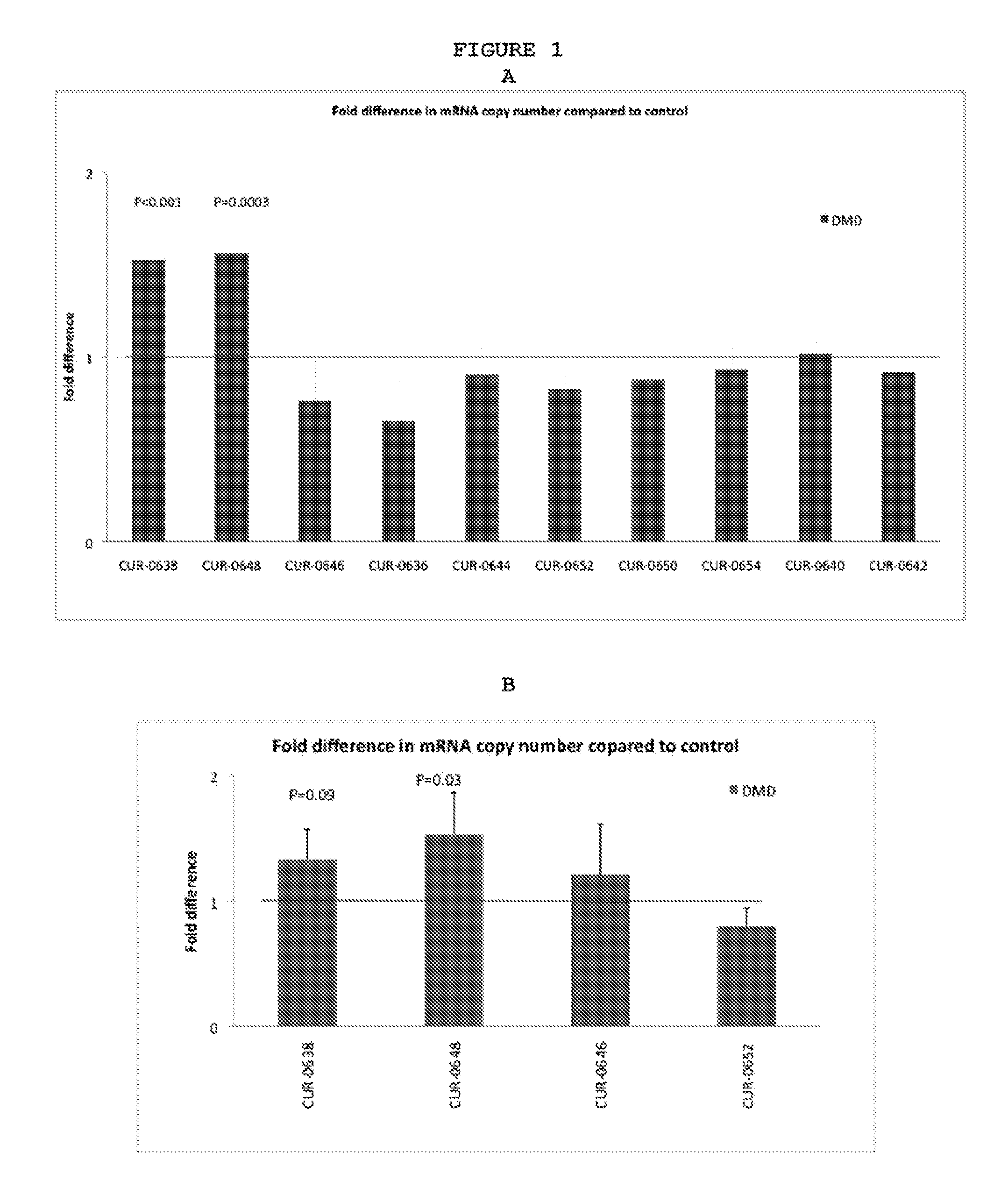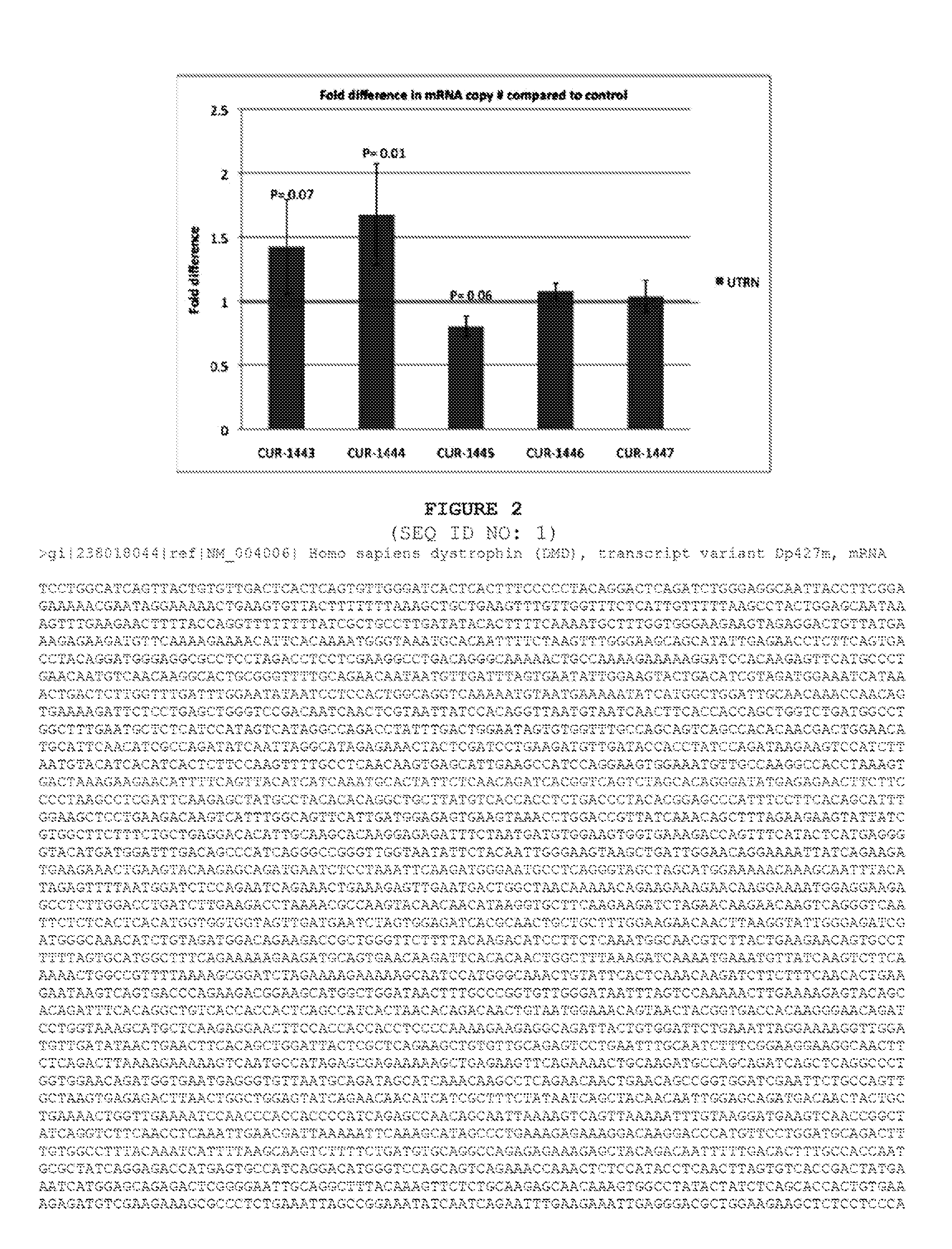Treatment of dystrophin family related diseases by inhibition of natural antisense transcript to dmd family
a technology of dystrophin and natural antisense, applied in the field of treatment of dystrophin family related diseases by inhibiting natural antisense transcript to dmd family, can solve the problems of interfering with rna splicing, transcription, translation, replication, etc., and achieve the effect of modulating function and/or expression
- Summary
- Abstract
- Description
- Claims
- Application Information
AI Technical Summary
Benefits of technology
Problems solved by technology
Method used
Image
Examples
example 1
Design of Antisense Oligonucleotides Specific for a Nucleic Acid Molecule Antisense to a Dystrophin Family and / or a Sense Strand of Dystrophin Family Polynucleotide
[0244]As indicated above the term “oligonucleotide specific for” or “oligonucleotide targets” refers to an oligonucleotide having a sequence (i) capable of forming a stable complex with a portion of the targeted gene, or (ii) capable of forming a stable duplex with a portion of an mRNA transcript of the targeted gene.
[0245]Selection of appropriate oligonucleotides is facilitated by using computer programs that automatically align nucleic acid sequences and indicate regions of identity or homology. Such programs are used, to compare nucleic acid sequences obtained, for example, by searching databases such as GenBank or by sequencing PCR products. Comparison of nucleic acid sequences from a range of species allows the selection of nucleic acid sequences that display an appropriate degree of identity between species, in the ...
example 2
Modulation of DMD Family Polynucleotides
[0253]Treatment of 518A2 Cells with Antisense Oligonucleotides
[0254]518A2 cells obtained from Albert Einstein-Montefiore Cancer Center, NY were grown in growth media (MEM / EBSS (Hyclone cat#SH30024, or Mediatech cat#MT-10-010-CV)+10% FBS (Mediatech cat#MT35-011-CV)+penicillin / streptomycin (Mediatech cat#MT30-002-CI)) at 3720 C. and 5% CO2. One day before the experiment the cells were reflated at the density of 1.5×105 / ml into 6 well plates and incubated at 37° C. and 5% CO2. On the day of the experiment the media in the 6 well plates was changed to fresh growth media. All antisense oligonucleotides were diluted to the concentration of 20 μM. Two μl of this solution was incubated with 400 μl of Opti-MEM media (Gibco cat#31985-070) and 4 μl of Lipofectamine 2000 (Invitrogen cat#11668019) at room temperature for 20 min and applied to each well of the 6 well plates with 518A2 cells. A Similar mixture including 2 μl of water instead of the oligonucl...
PUM
| Property | Measurement | Unit |
|---|---|---|
| Fraction | aaaaa | aaaaa |
| Fraction | aaaaa | aaaaa |
| Fraction | aaaaa | aaaaa |
Abstract
Description
Claims
Application Information
 Login to View More
Login to View More - R&D
- Intellectual Property
- Life Sciences
- Materials
- Tech Scout
- Unparalleled Data Quality
- Higher Quality Content
- 60% Fewer Hallucinations
Browse by: Latest US Patents, China's latest patents, Technical Efficacy Thesaurus, Application Domain, Technology Topic, Popular Technical Reports.
© 2025 PatSnap. All rights reserved.Legal|Privacy policy|Modern Slavery Act Transparency Statement|Sitemap|About US| Contact US: help@patsnap.com



